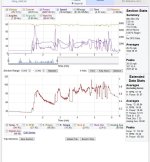fatty said:
Also, don't mind the resident troll, Chalo.
Troll with datalogs, fvcker.
Here is a datalog of a hub motor that is not cooled. Overvolted and with some very powerful batts. 100a limit, 72v battery. This hub fried in 700 miles and was refitted with new hall sensors. Thermal rolback was enacted, and the hub a was then filled with ATF and equipped with sinks. Then performance datalogged again. Over a thousand times. Oh yeah, did not leak, literally, a drop, Chalo.

This is the result of the thermal management. better power, more even averages, in temperature. Same hub. Same load. Only thing is different is the hub has 250mL of ATF in it, and equipped with sinks. Same very powerful, long lasting cheap battery. ( NOT leaking, Chalo.... ) .
More power, reliability, and performance. Better power from a 17 lb hub,, that, the 3Kw model comes in at 29 lbs for. Almost 2x the weight. Here is an early log with no limiting: You can see the (red) heat line trace creeps up slowly on the top log:... Until it gets into the danger zone and never really goes back down.
This (these) ride(s) looked like a fun one. Human power and Human tq. is also recorded. Along w everything else.
This hub consumed 20Wh/mile less upon cooling and thermal rollback. All that power and amps do make heat. Wasted heat. Energy you see come from the batt,but doesnt make you go any faster or accelerate harder. ZJust wasted away in heat.
Went from 70-80Wh/mile to about 40-50Wh/mile in the summer. Better or same power output, but more efficiency. YOu can see the PID loop trying to control the extremes of temperature at the lower log.
Does a decent job. I have the 29 lb motor 3Kw rated to datalog next in line. In hand.
For a few thousand mile since. I have run this light hub at 4x-8x its original OEM label rating. 80% of that is cause the oil and the thermal properties I know well. I did monitor shell temps, too, at the same time.
I got a few thousand of similar logs showing performance.



